Fact file:
Matriculated: 1914
Born: 25 April 1896
Died: 7 July 1917
Regiment: Royal Naval Air Service
Grave/Memorial: Pont-du-Hem Military Cemetery: IV.H.25
Family background
b. 25 April 1896 at The Farmlet, Codnor, Derbyshire, as the elder son of William Eyre (1836–1913) and his second wife, Clare Elizabeth Eyre (née Askew) (1868–1960) (m. 1894). At the time of the 1901 and 1911 Censuses, the family was living at The Farmlet, Quarndon/Codnor, Derbyshire (no servants).
Parents
Eyre’s paternal grandfather, Edward Eyre (1811–91) was a stone miner of Codnor, Derbyshire, but in 1881 at the age of 70 he was framework knitter. At his death his estate was valued at £43 17s. 1d. Eyre’s father was a grocer and draper employing at least one carter and was sufficiently successful to retire.
Eyre’s maternal grandfather was Edwin Askew (1835–1918); in 1867 he was made a minister of the United Methodist Free Church; in 1880 he was elected Connexional Secretary and was re-elected without opposition in the next three years. In 1884 he was elected President of the United Methodist Free Church, and then continued to be influential in the movement until his death. Eyre’s maternal grandmother was Anne France Burnett, the daughter of a Lincolnshire butcher.
On 30 December 1913, Dr Charles David Whittaker (1862–1925), the Headmaster of Taunton School from 1899 to 1922, wrote a letter to President Warren in which he said:
Mrs Ayre [sic] is a widow, her husband died recently after a very long and tedious illness, and as I have said, her means are very small. I think she told me that, including everything, her income did not exceed about £120.
Siblings and their families
Cyril Askew’s brother was Edward Geoffrey Askew (1898–1917); he was killed in action on 21 October 1917 while serving as a Flight Lieutenant with No. 4 Squadron, Royal Naval Air Service (RNAS). This Squadron had begun its existence as the Dover Defence Flight and became 4 Squadron, RNAS, on 25 March 1915. But on 3 August 1915 it moved to Eastchurch, Hampshire, where, on 27 August, as part of No. 4 Wing, RNAS, consisting of four Squadrons of six aircraft, it became the first RNAS Squadron to go abroad, in this case France, where it was based at Ostend and Dunkirk and tasked with defending the area against German airships. At the beginning of February 1917 the Squadron began offensive flights and in April 1917 it moved to Bray Dunes, on the coast near Dunkirk, where it began to fly offensive patrols in May 1917.
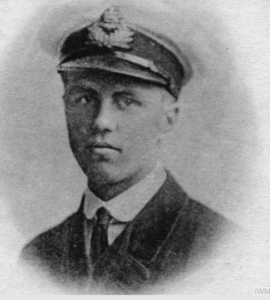
Edward Geoffrey Askew Eyre
IWM HU 121855
Edward Geoffrey joined the RNAS as a Probationary Flight Officer on 1 January 1917 and was stationed at Crystal Palace from 21 January to 3 March 1917, then at Vendȏme from 3 March to 26 May 1917, and he joined No. 4 Squadron, RNAS, as a Flight Sub-Lieutenant on 27 May 1917, just over 14 months before Richard Everleigh Hodgson, the brother of Francis Herbert Hodgson, joined it in August 1918. In June 1917, No. 4 Squadron was the first Squadron to be equipped with the Sopwith F.1 Camel, a highly manoeuvrable fighter aircraft that was not easy to fly but had a maximum speed of 115 mph, could reach 15,000 feet in just over 20 minutes, and was the first British aircraft to be equipped with twin Vickers guns that were synchronized to fire through the propeller. Pilots used to joke that it would get you a wooden cross, to the Red Cross, or a Victoria Cross.
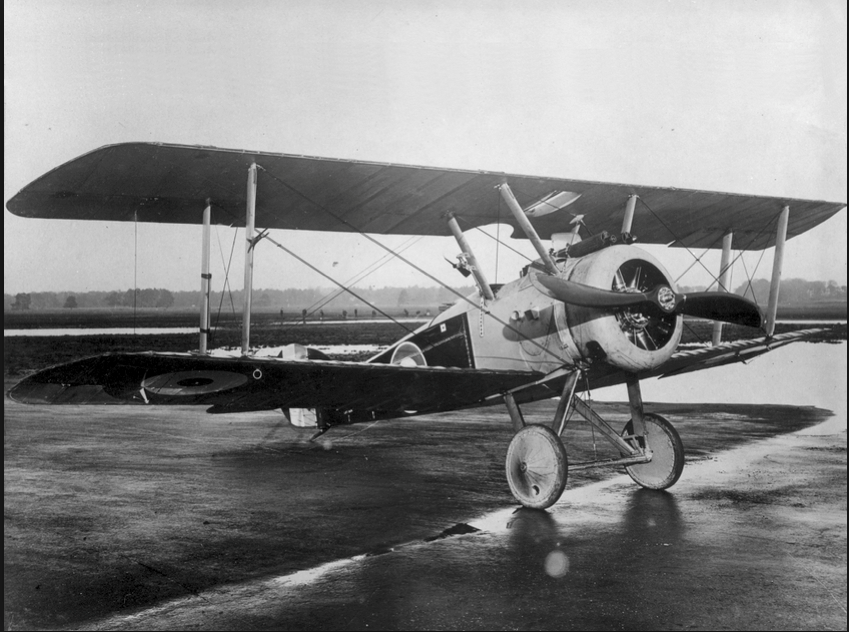
The Sopwith Camel
Edward Geoffrey was credited with shooting down three enemy aircraft – on 20 May, 14 June, and 21 October 1917, when he brought down one of Germany’s new Albatros Scouts, only to be killed in action on the same day near Schnelleghem, Belgium. Described by his superiors as a “good and keen officer” and “a very good pilot indeed”, he had logged 38 hours and 45 minutes flying time by the time of his death and fell to the guns of Oberleutnant Bruno Loerzer (1891–1960) of Jasta 26, one of Germany’s aces who, by the time of the Armistice, was credited with 44 victories. Edward Geoffrey has no known grave and is commemorated on his brother’s tombstone and the Flying Services Memorial at Arras. Loerzer joined Jasta 26 in January 1917 and had 20 victories to his credit by the end of October 1917, for which he was awarded the Pour le Mérite, Germany’s highest decoration at the time, in February 1918. From 28 October 1914 to late June 1915, Loerzer’s observer was none other than Hermann Goering (1893–1946), who helped him rise to the rank of Generaloberst der Luftwaffe (Air Marshal) by the time of his retirement in April 1945.
Education
From 1906 to 1909 Eyre attended Heanor Secondary School, Derbyshire, an institution that had been founded in 1893 as Heanor Technical College, was then rebuilt as the Heanor Secondary Technical School between 1910 and 1912, then turned into a grammar school in 1944, and was finally amalgamated with the South-East Derbyshire College in the 1970s. But from 1910 to 1914 he was a student of Taunton School, Somerset, a school that had been founded in 1847 for dissenters (such as Eyre’s maternal grandfather). Here, Eyre became a House Prefect and in his final year won the Addiscott Essay Prize. In December 1913, i.e. before Dr Whittaker wrote to President Warren about the financial circumstances of Eyre’s mother, Magdalen awarded Eyre an Open Exhibition in Modern History while he was still under 18. But as this would have covered only about one sixth of the total fees (£250–350 p.a.), one wonders whether Magdalen, which was one of the most expensive and well-endowed Oxford colleges, found him some extra money for his studies. Whatever, Eyre matriculated at Magdalen on 13 October 1914, having been exempted from Responsions because he had a London National Certificate. He took one part of the First Public Examination (Latin Prose) in Trinity Term 1914 and another (Greek) in September 1914. But he sat no more examinations after that and at the end of Trinity Term 1915 he left without a degree in order to join up.
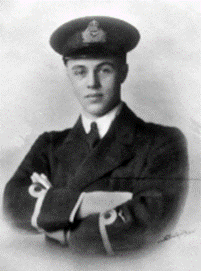
Cyril Askew Eyre
(Photo courtesy of Magdalen College, Oxford).
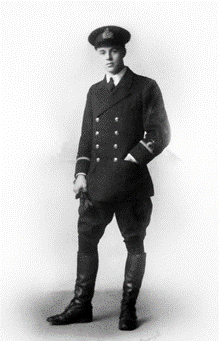
Cyril Askew Eyre
(Photo courtesy of Magdalen College, Oxford).
War service
Eyre had been in his school’s Officers’ Training Corps from 1913 to 1915, and after leaving Magdalen he joined the RNAS, possibly by way of Canada. He was commissioned as a Temporary Flight Sub-Lieutenant on 23 July 1915 (confirmed on 14 December 1915) and obtained his Aviator’s Certificate on a Maurice Farman biplane, probably a Shorthorn, at the Royal Naval Flying School at Eastchurch, Hampshire, between 23 July and 19 November 1915.
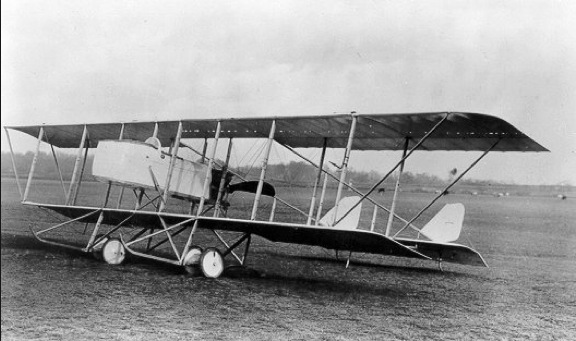
Farman Shorthorn (1915/16).
While learning to fly, Eyre fractured his wrist in an accident on 17 August 1915, and from 17 October to 8 November 1915 he was in hospital at Chatham suffering from measles. He remained at Eastchurch until 14 December 1915 and was then posted to the RNAS stations at Calshot, on the Solent, Hampshire, from 14 December 1915 to 17 January 1916, and then Killingholme, Lincolnshire, from 17 January 1916 to 28 February 1916. But in May 1916, he flew to the RNAS station at Dunkirk, on the north-western coast of France, where he became a founder member of ‘A’ Fighting Squadron, RNAS, otherwise known as “Detached Flight”. This unit was equipped with the new Sopwith Pup, officially known as the Sopwith Scout, and stationed on an airfield near Furnes, on the French coast between Dunkirk and the Belgian border, where its major task was the aerial defence of Dunkirk. The Pup was highly manoeuvrable, with a top speed of 103 mph at 9,000 feet, a service ceiling of 17,000 feet, and a single synchronized Vickers machine-gun that fired forward. As such, it maintained its ascendancy over most German aircraft, including the Fokker D[oppeldecker = biplane] III (Albatros) and the Fokker D[oppeldecker] V (Albatros) until about mid-1917. The Pup also had the distinction of being the first aircraft to take off from and land on a ship, whether a primitive aircraft carrier or a battleship or cruiser with a platform mounted above its forward gun-turrets.
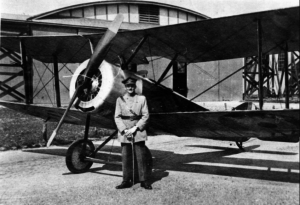
Captain Clive Collett, MC with his Sopwith Pup.
But on 22 June 1916, the first Sopwith Triplanes, which were faster and more manoeuvrable even than the Pup and could climb more rapidly to a higher service ceiling, were sent for service trials with ‘A’ Squadron at Furnes. Eyre was probably not involved with this testing since at this juncture he was not known as an aggressive pilot, and although he was promoted Flight Lieutenant, the equivalent of Captain, on 1 October 1916, he was not given the opportunity to fly a Triplane until after ‘A’ Squadron had officially become No. 1(N) Squadron on 5 December 1916. Consequently, Eyre’s first engagement with an enemy aircraft did not take place until 11 December 1916. The Triplanes entered service with 1(N) Squadron in February 1917 and gradually replaced its obsolescent, French-built Nieuport Scouts.
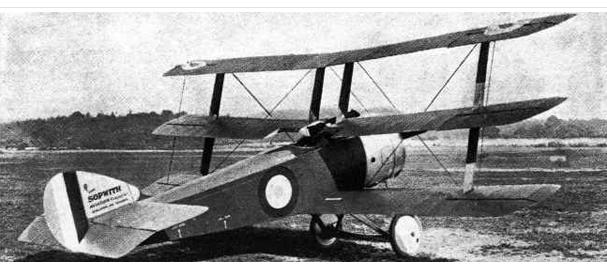
The Sopwith Triplane.
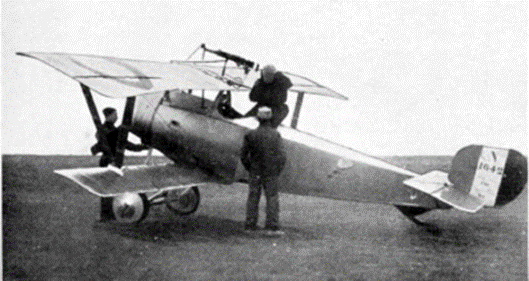
A French Nieuport Scout.
During this period, Eyre is recorded as flying from Crystal Palace to Vendȏme on 3 February. Once equipped with the new aircraft, the Squadron moved to Chipilly, about 15 miles east of Amiens, on 15 February 1917, where it became part of 14th Wing, 4th Brigade, and where it stayed until 11 April 1917, when it was transferred to La Bellevue to become part of 13th Wing, 3rd Brigade. During this period, Eyre is recorded as flying from Cranwell to Dover on 12 April and from Vendȏme to Cranwell on 26 May. By 1 June 1917, the whole Squadron had moved yet again, this time to Bailleul, as part of 11th Wing, 2nd Brigade. Eyre gradually gained in confidence during the first four months of 1917 and at 17.00 hours on 29 April 1917, he took off from Bailleul as the leader of an offensive patrol consisting of three Triplanes. At 17.45 hours it engaged three Albatros Scouts over Beaumont and during the ensuing dog-fight, Flight-Sub-Lieutenant Arthur Haywood was shot down after being badly wounded while driving down one of the enemy aircraft. After this experience, Eyre’s success as a pilot increased significantly: on 4 May 1917, he shot down an Albatros D.III near Wancourt, and on 19 May, while leading an early morning patrol of five Triplanes from ‘C’ Flight over the Arras Front, he shot down a second Albatros when his leading three Triplanes took on twice that number of hostile aircraft.
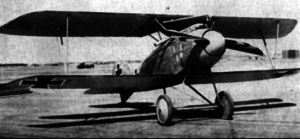
Fokker D.III (Albatros)
During the ensuing mêlée, one of Eyre’s pilots, Flight-Sub-Lieutenant Geoffrey Glendenning Bowman (1898–1917; no known grave), was brought down south of Péronne, in the area of Éterpigny/Dury, probably by Oberleutnant Adolf von Tutschek (1891–1918), the Commanding Officer of Jasta 12 since 28 April, a future holder of the Pour le Mérite (3 August 1917), and one of Germany’s top aces (27 victories, of which Bowman was the twelfth). Eyre may well have been present when his Squadron was involved in the large dog-fights of 4, 7, 8, 10 and 16 June that are described so graphically by Bailey and Taylor, and it is certain that on 15 June, the day after his promotion to Acting Flight Commander, he shot down an unidentified aircraft at Sint Jaan, north-east of Ypres.
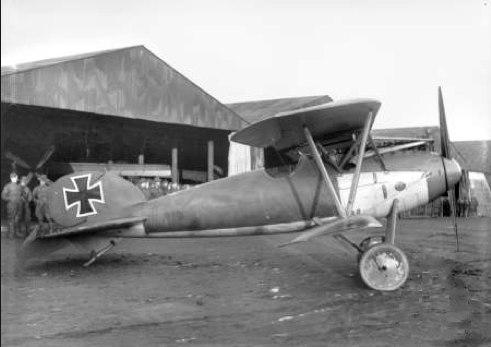
A captured Fokker D.V(a) (Albatros) at Armentières (1917).
On 21 June Eyre brought down a Fokker D.V (Albatros) at Sint Juliaan; by 25 June 1917 he had logged 161 hours of flying time and attracted such evaluations as “a good duty officer”; “a dashing, keen and skilled officer” who “has done much good work under fire [and who] possesses good knowledge of fighting tactics & is a good Scout Pilot”; on 30 June he shot down another enemy aircraft; and on 3 July he destroyed two Albatros D.IIIs over the Ypres Salient, one at Tenbrielen and one east of Gheluvelt. This brought his total of victories to six, making him an RNAS “ace”.
But on 7 July 1917, the day of his confirmation as a Flight Commander, Eyre’s luck ran out at about 11.00 hours while he was leading six aircraft from ‘A’ Flight who were acting as the escort to a photo-reconnaissance mission that had been carried out unsuccessfully on the previous day. Over Dadizeele, half-way between Ypres and Courtrai (Kortrijk), Eyre’s patrol was jumped by about 30 aircraft from several Jastas belonging to the crack von Richthofen Circus. Eyre’s escorting Triplanes waited too long before turning away from the photo-reconnaissance aircraft in order to defend themselves. As a result they became isolated and three of them were destroyed. Flight-Sub-Lieutenants Kenneth H. Millward (1897–1917) and Donald Wyand Ramsay (1897–1917) were the first to fall, at 11.00 and 11.05 hours respectively, to the guns of Leutnant Kurt Wolff (1895–1917) of Jasta 11, based at Marckbeke just south-west of Courtrai (his 33rd victory), and Leutnant Richard Kruger of Jasta 4, also based at Marckbeke (Kruger’s first and only victory). Then, at 11.10 hours, after last being seen taking on six of the enemy aircraft, Eyre was brought down, aged 21, by Leutnant Alfred Niederhoff (1895–1917), who, with two victories to his credit, had joined Jasta 11 from Jasta 20 at von Richthofen’s request on 30 April 1917. Eyre’s Sopwith Triplane (N6291) crashed with such force on the banks of the Lys River near Bousbeque, five miles from Dadizeele, south-west of Menin and just south of the Franco-Belgian border, that it was nothing more than “a pile of rubble” and Eyre’s skull was completely crushed. All the reconnaissance machines returned home safely.
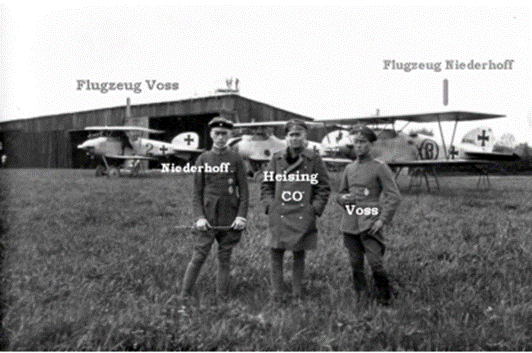
Lt. Alfred Niederhoff (1895-1917) is the young pilot on the left of the trio; his Fokker D.V (Albatros) is the one on the right of the photo (1917).
Despite the promise of his seven victories, of which Eyre was the fourth, Niederhoff would be killed in action later on in the same month, as would Kruger, whereas Wolff survived until 15 September 1917. One of Eyre’s three Canadian comrades who survived the fight later paid their Flight Commander a compliment by implying that if he and his comrades had not brought the fight so aggressively to more than twice their number of enemy aircraft, their whole patrol would have been shot down. Eyre and Millward are buried in Pont-du-Hem Military Cemetery (Estaires–La Bassée road), La Gorgue; Graves IV.H.25 and IV.H.24 respectively; Ramsay is buried in the Bousbeque Communal Cemetery, facing the War Memorial. Eyre’s headstone is inscribed: “Also in memory of Flight Sub-Lieutenant E.G.A. Eyre, RN, 4th Sqdn RNAS, 21st October 1917, age 19. In their death they were not divided” (2 Samuel 1:23). The two Eyre brothers are also commemorated on the Codnor War Memorial and the Taunton School War Memorial. Eyre left £202 2s. 3d.

Pont-du-Hem Military Cemy (Estaires-La Bassée Rd), La Gorgue; Grave IV.H.25. The lettering in the soft limestone is very hard to read.
The delivery of Triplanes ceased in July 1917, but 1(N) Squadron continued to fly them from Bailleul until November of that year, when it was assigned to the Royal Flying Corps and re-equipped with the new Sopwith Camel, which had first entered Squadron service on the Western Front with 4(N) Squadron, RNAS, in June 1917.
Bibliography
For the books and archives referred to here in short form, refer to the Slow Dusk Bibliography and Archival Sources.
Special acknowledgement:
*Frank Bailey and Steward K. Taylor, ‘Royal Naval Air Service Sopwith Triplane Casualties’, Over the Front, 10, no. 4 (1995), pp. 312–34 (esp. pp. 314, 315, 316 (photo of Eyre in full flying gear) 322).
Printed sources:
[Anon.], ‘Flight Sub-Lieutenant Donald W. Ramsey’ [obituary], The Times, no. 41,601(5 October 1917), p. 11.
[Thomas Herbert Warren], ‘Oxford’s Sacrifice’ [obituary], The Oxford Magazine, 36, no. 1 (19 October 1917), p. 9.
Owen Thetford, British Naval Aircraft since 1912, 4th revised edition (London: Putnam, 1978), pp. 252–3, 258–9, 298–305.
Norman Franks, Sopwith Triplane Aces of World War I (Aircraft of the Aces, no. 62) (Oxford: Osprey, 2004).
Archival sources:
Derbyshire County Record Office: D1635, D1635/EA, D1635/EA/1 (Documents relating to Heanor Secondary School, Derbyshire).
MCA: PR32/C/3/438-447 (President Warren’s War-Time Correspondence, Letters relating to C.A. Eyre [1913–1917]).
MCA: Ms. 876 (III), vol. 1.
OUA: UR 2/1/86.
ADM 273/6/270.
ADM 273/12/88.
ADM 273/29/454.
AIR1/695/21/20/204.
AIR76/155/95.
AIR76/155/96.
AIR76/155/28189.
On-line sources:
Bridget Pollard, ‘The Royal Naval Air Service in Antwerp, September–October 1914’, British Commission for Military History: http://www.bcmh.org.uk/archive/articles/RNASAntwerpPollard.pdf (accessed 11 April 2019).